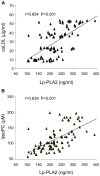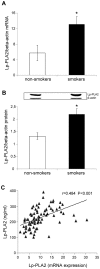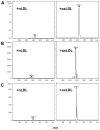Lysophosphatidylcholine and carotid intima-media thickness in young smokers: a role for oxidized LDL-induced expression of PBMC lipoprotein-associated phospholipase A2?
- PMID: 24358251
- PMCID: PMC3866188
- DOI: 10.1371/journal.pone.0083092
Lysophosphatidylcholine and carotid intima-media thickness in young smokers: a role for oxidized LDL-induced expression of PBMC lipoprotein-associated phospholipase A2?
Abstract
Background: Although cigarette smoking has been associated with carotid intima-media thickness (CIMT) the mechanisms are yet not completely known. Lysophosphatidylcholine (lysoPC), a main product of lipoprotein-associated phospholipase A2 (Lp-PLA2) activity, appears to be a major determinant of the pro-atherogenic properties of oxidized LDL (oxLDL) and to induce proteoglycan synthesis, a main player in intimal thickening. In this study we assessed whether cigarette smoking-induced oxidative stress may influence plasma Lp-PLA2 and lysoPC and Lp-PLA2 expression in peripheral blood mononuclear cells (PBMC), as well as the relationship between lysoPC and CIMT.
Methods/results: 45 healthy smokers and 45 age and sex-matched subjects participated in this study. Smokers, compared to non-smokers, showed increased plasma concentrations of oxLDL, Lp-PLA2 and lysoPC together with up-regulation of Lp-PLA2 (mRNA and protein) expression in PBMC (P<0.001). Plasma Lp-PLA2 positively correlated with both lysoPC (r=0.639, P<0.001) and PBMC mRNA Lp-PLA2 (r=0.484, P<0.001) in all subjects. Moreover CIMT that was higher in smokers (P<0.001), positively correlated with lysoPC (r=0.55, P<0.001). Then in in vitro study we demonstrated that both oxLDL (at concentrations similar to those found in smoker's serum) and oxidized phospholipids contained in oxLDL, were able to up-regulate mRNA Lp-PLA2 in PBMC. This effect was likely due, at least in part, to the enrichment in oxidized phospholipids found in PBMC after exposure to oxLDL. Our results also showed that in human aortic smooth muscle cells lysoPC, at concentrations similar to those found in smokers, increased the expression of biglycan and versican, two main proteoglycans.
Conclusions: In smokers a further effect of raised oxidative stress is the up-regulation of Lp-PLA2 expression in PBMC with subsequent increase of plasma Lp-PLA2 and lysoPC. Moreover the correlation between lysoPC and CIMT together with the finding that lysoPC up-regulates proteoglycan synthesis suggests that lysoPC may be a link between smoking and intimal thickening.
Conflict of interest statement
Figures







Similar articles
-
Role of lipoprotein-associated phospholipase A2 in leukocyte activation and inflammatory responses.Atherosclerosis. 2007 Mar;191(1):54-62. doi: 10.1016/j.atherosclerosis.2006.05.001. Epub 2006 Jun 9. Atherosclerosis. 2007. PMID: 16765356
-
OxLDL stimulates lipoprotein-associated phospholipase A2 expression in THP-1 monocytes via PI3K and p38 MAPK pathways.Cardiovasc Res. 2010 Mar 1;85(4):845-52. doi: 10.1093/cvr/cvp367. Epub 2009 Nov 12. Cardiovasc Res. 2010. PMID: 19910444
-
Oxidized LDL induces procoagulant profiles by increasing lysophosphatidylcholine levels, lysophosphatidylethanolamine levels, and Lp-PLA2 activity in borderline hypercholesterolemia.Nutr Metab Cardiovasc Dis. 2020 Jun 25;30(7):1137-1146. doi: 10.1016/j.numecd.2020.03.015. Epub 2020 Mar 27. Nutr Metab Cardiovasc Dis. 2020. PMID: 32456947
-
Oxidized phospholipids and lipoprotein-associated phospholipase A2 (Lp-PLA2 ) in atherosclerotic cardiovascular disease: An update.Biofactors. 2022 Nov;48(6):1257-1270. doi: 10.1002/biof.1890. Epub 2022 Oct 3. Biofactors. 2022. PMID: 36192834 Review.
-
Pathophysiological role and clinical significance of lipoprotein-associated phospholipase A₂ (Lp-PLA₂) bound to LDL and HDL.Curr Pharm Des. 2014;20(40):6256-69. doi: 10.2174/1381612820666140622200916. Curr Pharm Des. 2014. PMID: 24953389 Review.
Cited by
-
Replacing carbohydrate with protein and fat in prediabetes or type-2 diabetes: greater effect on metabolites in PBMC than plasma.Nutr Metab (Lond). 2016 Jan 19;13:3. doi: 10.1186/s12986-016-0063-4. eCollection 2016. Nutr Metab (Lond). 2016. PMID: 26788114 Free PMC article.
-
The role of oxidised self-lipids and alveolar macrophage CD1b expression in COPD.Sci Rep. 2021 Feb 18;11(1):4106. doi: 10.1038/s41598-021-82481-0. Sci Rep. 2021. PMID: 33602992 Free PMC article.
-
AMP-activated protein kinase mediates the effects of lipoprotein-associated phospholipase A2 on endothelial dysfunction in atherosclerosis.Exp Ther Med. 2017 Apr;13(4):1622-1629. doi: 10.3892/etm.2017.4142. Epub 2017 Feb 21. Exp Ther Med. 2017. PMID: 28413519 Free PMC article.
-
Correlation between smoking and serum lipoprotein-associated phospholipase A2 level in overweight and obese men.Zhong Nan Da Xue Xue Bao Yi Xue Ban. 2023 Feb 28;48(2):191-197. doi: 10.11817/j.issn.1672-7347.2023.210457. Zhong Nan Da Xue Xue Bao Yi Xue Ban. 2023. PMID: 36999465 Free PMC article. Chinese, English.
-
Lipidome and transcriptome profiling of pneumolysin intoxication identifies networks involved in statin-conferred protection of airway epithelial cells.Sci Rep. 2015 May 29;5:10624. doi: 10.1038/srep10624. Sci Rep. 2015. PMID: 26023727 Free PMC article.
References
Publication types
MeSH terms
Substances
LinkOut - more resources
Full Text Sources
Other Literature Sources

